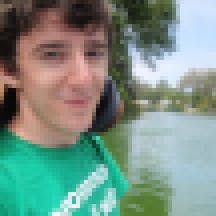Andrew Sutherland had no idea that the thing he programmed as a 15 year old would become a full-time profession. The kid was just trying to pass high school French.
Fast forward 14 years. Quizlet, the studying tool he built in 2005, is now one of the most widely used education apps, claiming more than 50 million active users in 130 countries who have created over 300 million study sets. And unlike most education software, Quizlet has attracted a loyal following among students who often rave about its features with a passion usually reserved for sports teams and celebrities.
Seasoned entrepreneurs fail all the time. (Ninety percent of startups fail, so the mantra goes.) So how did a San Francisco Bay Area high school sophomore create one of the most popular edtech products of all time? And what can the students of today and tomorrow with similar aspirations learn from his journey?
“I was just kind of winging it,” Sutherland admits.
Sutherland, now Quizlet’s chief technology officer, says he didn’t think too much about a business plan back when he started. It was to solve a problem, and that laser-like focus has proven to be a viable strategy for long-term success. He didn’t create Quizlet with the intent of raising funding capital or selling to an audience; it was to address a specific pain point for Sutherland and his classmates. As the platform became popular, that student-first approach has remained the standard. For teenagers, the company’s collaborative study sets and competitive vocab games often feel more like a fun social experience than a study tool.

“People made assumptions that I didn’t have enough experience to make a big decision or to manage people,” says Sutherland. As it turned out, he could do both. But he says the core reason Quizlet grew into a dominant force was his student-first commitment.
There are many Andrew Sutherlands out there today. Students all over the world are tackling problems that personally ail them and their peers, and creating solutions and collaborative partnerships with get-it-done energy and hustle. Like Sutherland, they are driven by a simple mission that at its root defines student entrepreneurship.
Bridging Different Perspectives
An unadulterated and authentic purpose often propels these efforts.
Clara Nevins, a 19-year-old Southern Californian currently attending Harvard University, co-founded Bridge the Divide three years ago in the wake of the 2016 election. The idea came after a series of heated arguments turned into powerful and ultimately constructive debates between herself, a self-identified liberal, and her co-founder Joseph Touma, a West Virginian with strong conservative views. Entirely student-run, Bridge the Divide now connects students from nearly 30 countries to share their opinions and perspectives on a range of issues.

Its growth has led to a new edtech spin-off, Mismatch, where Nevins is working with a team of adult education professionals to launch a school-based platform that “works like a dating site but instead introduces you to your political ‘other’ and guides you in a structured video,” according to a video on its website. Students and classrooms from different geographical and political leanings are connected to discuss hot-button issues, led by guided discussion.
“Having someone [guide these conversations] who’s been in the classroom is really helpful because I can look at [Mismatch’s] curriculum and assess what I would find that is interesting or want to learn, versus an adult who has not been in the classroom for several years,” Nevins tells EdSurge. Her approach to entrepreneurship has proved fruitful so far; Mismatch has raised $80,000 in funding and its tool has already been piloted by users.
Never Too Young to Dream (or Sleep)
Solving problems shared by one’s peers is what drove Orvil Escalante, an Oakland, Calif.-based 10th grader, to create DreamTime, an app that offers music, journaling, and scheduling features to help him and his peers sleep better. So far it’s been used mostly by his family and friends, but that doesn’t discourage Escalante from looking toward the future. “The fact that I don’t know where it could lead really drives me forward,” he says.

He didn’t create DreamTime for it to be the next viral trend, but rather to address an issue that nearly everyone can appreciate: getting more sleep. The hardest part, Escalante says, was “knowing where to start.” Being a part of Google’s Code Next program, a free 4-year computer science program for Black and Latinx high schoolers, was the key catalyst in helping Escalante formulate his idea and learn how to code a working product to mirror his vision.
Though he is unsure how far he will pursue DreamTime, in the near future he wants to continue developing the app. From this experience, he has gained more experience in programming and building a team than he ever could from the classroom. He says he has “learned perseverance and that the answers are always there,” and that “there is so much possibility to create.”
Seeing Challenges as Opportunities
Sidharth Anantha, a rising senior at Lexington High School in Massachusetts and founder of Kybyte Robotics Club and Seeing for the Blind, doesn’t see being young as a barrier to pursuing one’s passions. “All that matters is your perspective, your willingness to keep trying, pursuing and persevering,” he says. “There is a divide between young and old, but this divide is what makes entrepreneurship so great.”
Anantha cultivated a passion for robotics at a young age and was given the opportunity to develop and offer his own courses through Kybyte, an organization that provides computer science education for K-12 students. In the past two years, the program has grown from two students fiddling with Arduino devices to more than 100 students who have won national competitions. Anantha now manages more than 20 student-teachers and creates curriculum guides.

While running Kybte, Anantha used his love of robotics to create Seeing for the Blind. On a family trip to India, he was taken aback by an elderly blind woman on the bus who was struggling to find her seat. From that point on, he decided to create a product to make life for the blind a little easier. Currently, he is piloting and testing his “seeing” glasses in four cities.
Anantha says a key aspect to his journey has been “surrounding himself by peers who want the best for me and are not trying to compete.” That mindset has created a space of collaboration for him where when diverse perspectives come together, they can truly create something incredible. He says he and his friends learn from each other and grow as individuals.
Sacrifices of Being a Student Entrepreneur
But being a student entrepreneur is not without its struggles. Anantha says he doesn’t even set an alarm in the morning; he sets a timer for 6 hours and wakes up whenever it goes off and starts his work. Some days he is up at 4 a.m. developing new features or finishing up some problem sets. Sutherland recalls he often got only got four hours of sleep a night while he was working on Quizlet at MIT.
Juggling the demands of being a full-time student and full-time entrepreneur is difficult. What it comes down to is prioritization and time management, the student-founders say. And difficult sacrifices. When entrepreneurship became too time-consuming for Sutherland, he decided to drop out of college.
Student entrepreneurs are also not always taken seriously. At meetings, Nevins is often not addressed when she is sitting next to her co-director. “They see that I’m young and don’t think that I have the power, motivation, or credibility. It can be frustrating when people don’t really take me seriously.”
This feeling can be common among student entrepreneurs. No matter how many times they create products that change the world, they are always initially looked at with skepticism.
But that doubt only fuels their driven even more. “Give us a chance and you will see. Give us a chance and we’ll prove you wrong,” Anantha emphatically states.


